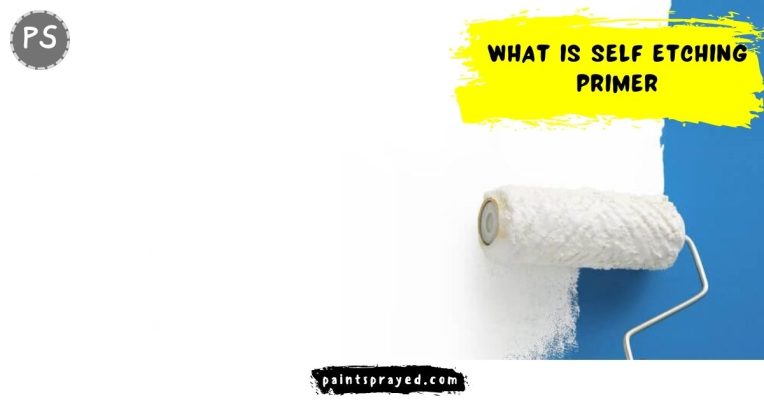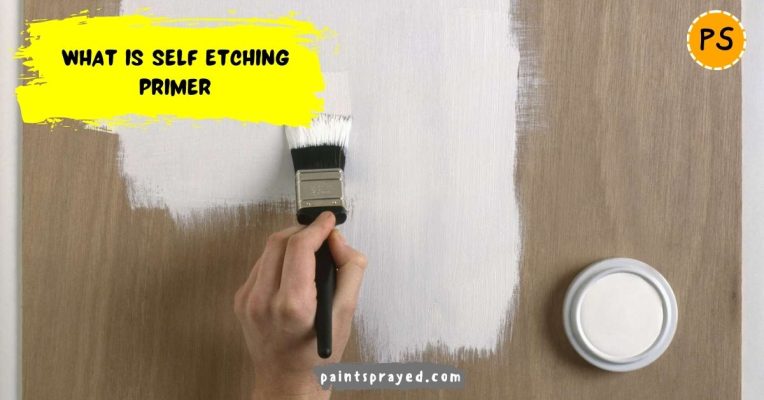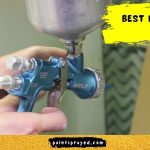Self-etching primer is a type of primer that etches the surface it’s applied to and then primes it in one step, eliminating the need for a separate etching step.
This guide what is self etching primer blog post written by an experienced painter for those new painters who want to know about it.
It contains an acid that chemically prepares the surface for bonding, and a primer to promote adhesion. It is commonly used in automotive and marine applications.
What is self etching primer?
Self-etching primer is a type of primer that has both an etching and priming function in one product.
It is used in a variety of applications, including automotive, marine, and metalworking.
The primer is designed to prepare the surface for painting or coating by chemically etching the surface and priming it at the same time.
This eliminates the need for a separate etching step, making the painting process faster and easier.
Self-etching primer is formulated with an acid that prepares the surface for bonding by removing any oils, grime, or other contaminants.
The acid reacts with the surface, creating a rough texture that allows the primer to grip the surface and ensure a strong bond.
This also helps to improve the adhesion of the topcoat and helps to prevent peeling or chipping of the paint.
Self-etching primer is typically used on bare metal surfaces such as aluminum, stainless steel, and iron.
It can also be used on other surfaces, such as plastic, but it is important to ensure that the surface is compatible with the primer before use.
The primer should be applied in thin, even coats, allowing each coat to dry completely before applying the next.
The recommended drying time will vary depending on the manufacturer and the ambient temperature and humidity.
Self-etching primer is an excellent choice for a variety of applications, including automotive and marine.
Automotive applications include repairing small rust spots, filling dents, and painting or repainting a vehicle.
In the marine industry, self-etching primer is used to prepare boat hulls, decks, and other metal surfaces for painting or coating.
It is also commonly used in metalworking, particularly in the production of metal parts, to prepare the surface for plating or painting.
One of the main advantages of self-etching primer is its convenience.
By combining the etching and priming functions in one product, it saves time and reduces the number of steps required in the painting process.
This makes it ideal for DIY projects and for use by professional painters who need to complete projects quickly and efficiently.
Another advantage of self-etching primer is its versatility. It can be used on a variety of surfaces, including bare metal, plastic, and fiberglass.
This makes it a versatile choice for a wide range of applications. It is also available in a variety of formulas to meet the specific needs of different surfaces and environments.
In addition to its versatility and convenience, self-etching primer also offers excellent adhesion and corrosion resistance.
The rough texture created by the etching process helps to improve the adhesion of the primer and topcoat, while the primer itself provides protection against corrosion.
This is particularly important in automotive and marine applications, where exposure to the elements can cause metal surfaces to rust and corrode.
Despite its many advantages, there are a few potential drawbacks to self-etching primer. One of the most important is compatibility.
Not all surfaces are compatible with self-etching primer, and it is important to ensure that the surface is suitable for use with the primer before application.

In addition, self-etching primer can be more expensive than other types of primer, making it less cost-effective for large projects.
What is the difference between self-etching primer and regular primer?
Self-etching primer and regular primer differ in the following ways:
- Function: Self-etching primer combines both an etching and priming function in one product, while regular primer only serves as a bonding layer between the surface and topcoat. Self-etching primer chemically prepares the surface for painting by etching it and priming it at the same time, while the regular primer is used to improve the adhesion of the topcoat.
- Surface Preparation: Self-etching primer requires less surface preparation, as it prepares the surface for painting by etching it and priming it in one step. Regular primer requires the surface to be cleaned and prepped before application, as it does not have an etching function.
- Compatibility: Self-etching primer is typically used on bare metal surfaces and some plastics, while regular primer can be used on a variety of surfaces, including wood, drywall, and masonry.
- Corrosion Resistance: Self-etching primer provides improved corrosion resistance compared to regular primer, as it chemically prepares the surface for painting and provides a barrier against rust and corrosion.
- Drying Time: Self-etching primer typically has a longer drying time than regular primer, as it must etch and prime the surface before the topcoat can be applied.
In conclusion, self-etching primer is a time-saving and convenient option for preparing bare metal surfaces and some plastics for painting.
While regular primer is a versatile option that can be used on a variety of surfaces for improved adhesion and bonding of the topcoat.
The choice between the two will depend on the surface to be painted and the desired outcome.
When should I use self-etching primer?
Self-etching primer is typically used on bare metal surfaces and some plastics when a fast and convenient way of preparing the surface for painting is needed.
It is used in the following applications:
- Automotive Repair: To repair small rust spots, fill dents, and prepare surfaces for painting or repainting a vehicle.
- Marine: To prepare boat hulls, decks, and other metal surfaces for painting or coating.
- Metalworking: To prepare metal parts for plating or painting.
- DIY Projects: As a convenient and time-saving option for DIY projects.
It is important to check the manufacturer’s recommendations before using self-etching primer to ensure that the surface is compatible with the product.
Additionally, self-etching primer should be used in a well-ventilated area and with appropriate protective equipment, as it contains an acid that can cause skin and eye irritation.
What is the advantage of self-etching primer?
Self-etching primer offers several advantages, including:
- Surface Preparation: Self-etching primer prepares the surface for painting by etching it and priming it in one step, which reduces the need for surface preparation.
- Time-Saving: Self-etching primer is a time-saving option compared to using an etching primer and a separate priming coat, as it combines both functions in one product.
- Improved Adhesion: Self-etching primer provides improved adhesion compared to bare metal surfaces, which can reduce the risk of peeling or chipping of the topcoat.
- Corrosion Resistance: Self-etching primer provides improved corrosion resistance compared to bare metal surfaces, as it chemically prepares the surface for painting and provides a barrier against rust and corrosion.
- Convenience: Self-etching primer is a convenient option for DIY projects and small repairs, as it does not require specialized tools or knowledge.
It is important to note that self-etching primer should only be used on bare metal surfaces and some plastics.
And it should be used in a well-ventilated area and with appropriate protective equipment, as it contains an acid that can cause skin and eye irritation.
Can you paint directly over self-etching primer?
Yes, you can paint directly over self-etching primer, as it is designed to act as a base for the topcoat.
However, it is important to follow the manufacturer’s recommendations for curing times and paint type.
As some self-etching primers may require a specific type of paint or a longer curing time before the topcoat can be applied.
Additionally, it is recommended to check the compatibility of the self-etching primer with the topcoat and to test a small area before applying the topcoat to the entire surface.
Proper surface preparation, such as cleaning and sanding the surface, can also improve the adhesion and appearance of the topcoat.

When and where to use Self-etching primer?
Self-etching primer is typically used on bare metal surfaces, such as aluminum, stainless steel, iron, and brass, as well as some plastics. It is used in the following applications:
- Automotive Repair: Self-etching primer is used to repair small rust spots, fill dents, and prepare surfaces for painting or repainting a vehicle.
- Marine: Self-etching primer is used to prepare boat hulls, decks, and other metal surfaces for painting or coating.
- Metalworking: Self-etching primer is used in metalworking to prepare metal parts for plating or painting.
- DIY Projects: Self-etching primer is a popular choice for DIY projects due to its convenience and time-saving benefits.
It is important to note that not all surfaces are compatible with self-etching primer.
Before using the primer, it is important to check the manufacturer’s recommendations to ensure that the surface is suitable for use.
In addition, self-etching primer should be used in a well-ventilated area and appropriate protective equipment should be worn.
As the primer contains an acid that can cause skin and eye irritation.
Final thoughts on What is self etching primer
In conclusion, a self-etching primer is a versatile, convenient, and effective product for preparing surfaces for painting or coating.
It combines the functions of etching and priming in one product, saving time and reducing the number of steps required in the painting process.
It offers excellent adhesion and corrosion resistance, making it ideal for a variety of applications, including automotive and marine.
However, it is important to ensure that the surface is compatible with self-etching primer before use, and to carefully follow the

Matthew Edward is a professional painter who loves to paint and wants to share useful tips and tricks which he had learned in many years of experience in painting. He also used many products that can be used for painting he has tried and tested each and every product to give an unbias opinion about it in his review. This blog is very useful for those newbies who want to learn painting without making mistakes.







